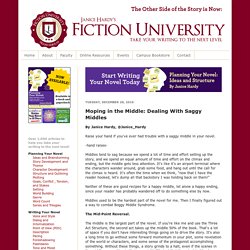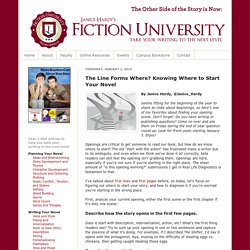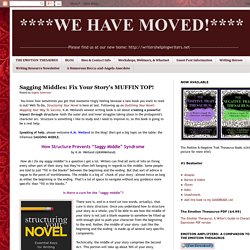

Moping in the Middle: Dealing With Saggy Middles. By Janice Hardy, @Janice_Hardy Raise your hand if you've ever had trouble with a saggy middle in your novel.

-hand raises- Middles tend to sag because we spend a lot of time and effort setting up the story, and we spend an equal amount of time and effort on the climax and ending, but the middle gets less attention. It's like it's an airport terminal where the characters wander around, grab some food, and hang out until the call for the climax is heard. It's often the time when we think, "now that I have the reader hooked, let's dump all that backstory I was holding back on them! " Neither of these are good recipes for a happy middle, let alone a happy ending, since your reader has probably wandered off to do something else by now. Middles used to be the hardest part of the novel for me. The Mid-Point Reversal. 4 Tips for Writing Reversals » Writeonsisters.com. Print this Post One of the most important scenes in any book is the midpoint reversal.

Mythcreants » Nine Questions to Ask About Your Draft. The Line Forms Where? Knowing Where to Start Your Novel. By Janice Hardy, @Janice_Hardy Seems fitting for the beginning of the year to share an oldie about beginnings, so here's one of my favorites about finding your opening scene.

Don't forget: Do you have writing or publishing questions? Come on over and ask them on Friday during the end of year question round up. Look for fresh posts starting January 5. Enjoy! Openings are critical to get someone to read our book, but how do we know where to start? I've talked about first lines and first pages before, so today, let's focus on figuring out where to start your story, and how to diagnose it if you're worried you're starting in the wrong place. First, analyze your current opening, either the first scene or the first chapter if it's only one scene: Describe how the story opens in the first few pages. Does it start with description, internalization, action, etc?
Describe the goal in the opening scene. Sagging Middles: Fix Your Story's MUFFIN TOP! You know how sometimes you get that awesome tingly feeling because a new book you want to read is out?

Well Ta-Da, Structuring Your Novel is here at last. Following up on Outlining Your Novel: Mapping Your Way To Success, K.M. Weiland's newest writing book is all about creating a powerful impact through structure--both the outer plot and inner struggles taking place in the protagonist's character arc. Structure is something I like to study and I need to improve in, so this book is going to be a real help. Speaking of help, please welcome K.M. Story Structure 104: The Juicy Details - Channel 101 Wiki.
By Dan Harmon Okay, here's that part where the self appointed guru tells you exactly what needs to happen and when.

I hope I've made it clear to you before I do that that the REAL structure of any good story is simply circular - a descent into the unknown and eventual return - and that any specific descriptions of that process are specific to you and your story. Here is my detailed description of the steps on the circle. I'm going to get really specific, and I'm not going to bother saying, "there are some exceptions to this" over and over.
There are some exceptions to everything, but that's called style, not structure. . 1. The audience is floating freely, like a ghost, until you give them a place to land. This free floating effect can be exploited for a while - closing in on the planet Earth; panning across a dirty shed. How do you put the audience into a character? If there are choices, the audience picks someone to whom they relate. Plotting the Non-Plot-Driven Novel. Have you ever grown impatient with a novel?

Have you ever restlessly flipped ahead wishing that something would happen? Of course. It’s a common feeling. Put politely, you feel frustrated. Put plainly, you’re bored. Perhaps your own current manuscript has also had you feeling, at times, impatient. If you answered yes then I have bad news for you: Your readers are going to feel impatient too.
As a non-plot driven novelist your frustration can deepen when you consider classics and contemporary literary successes. There’s nothing wrong with writing about the human condition. Fortunately there are ways to “plot” the non-plot driven novel. First, recognize that what holds a non-plot novel together and what gives it propulsive force every step of the way are two different issues. Second, let’s generalize. What Makes a Story’s Black Moment a Black Moment? If you’ve seen or used beat sheets before, you’ve probably noticed a beat that is often called the Black Moment.

The Black Moment is usually one of the most emotional sections of a story, so it can be difficult to pull together. It doesn’t help that different beat sheets will sometimes place the Black Moment in slightly different places in the story. Or that different story structure systems use different names for the beat.
A Black Moment plot point beat might also be called Crisis, Second Plot Point, All Is Lost, or Break Into (Act) Three. It’s enough to make us crazy and worry that we don’t know what we’re doing. But as I’ve mentioned before, the names of the beats don’t matter. An event that steals the protagonist’s hope for a solution And if we read stories (or watch movies), we’ve seen this beat play out endless times, so we probably understand the plot point more than we may think. The Black Moment: The What At some point in our story, our character will symbolically “die.”